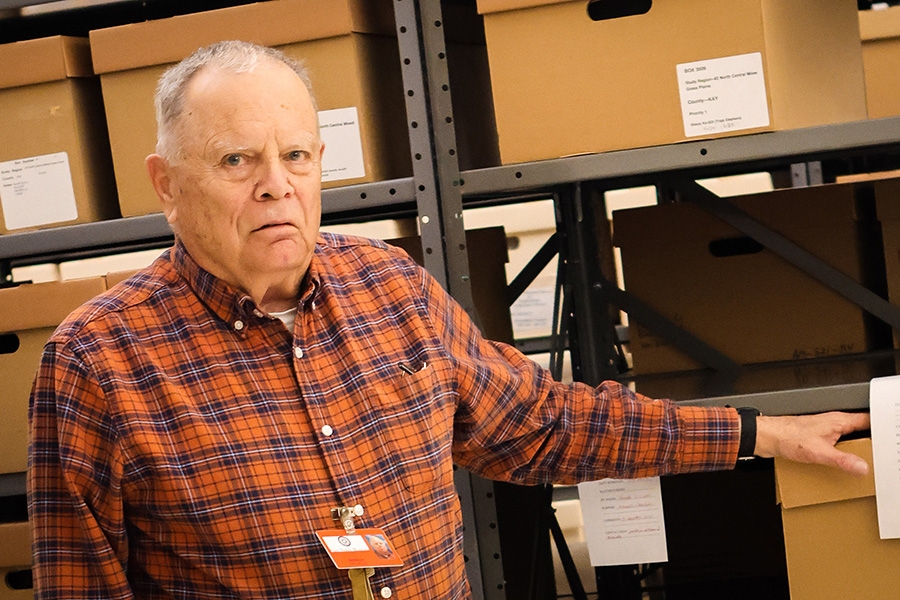
NORMAN, OKLA. – The Society for American Archaeology recently named Norman resident Gerald Franklin as the recipient of its annual Crabtree Award for Avocational Archaeology. Presented for significant contributions to the collective understanding of archaeology, the Crabtree Award is given to individuals who support the field of archaeology as hobbyists or volunteers rather than in an official or professional capacity. After serving more than 1,000 volunteer hours with the Sam Noble Oklahoma Museum of Natural History and the Oklahoma Professional Archaeology Network, this year’s award was presented to Franklin in recognition of the contributions he has made to the field of archaeology through his unique skillset as a blacksmith, cattleman and veteran.
“I believe that my total number of hours is in the neighborhood of 1,350 or so,” Franklin said. “I keep coming back because I’m selfish. I get more out of the work personally than the museum gets from me. I enjoy the feeling of accomplishment that when I finish assessing and cataloging a collection from an ancient site.”
However, Sam Noble Museum staff and officials with the Society for American Archaeology believe Franklin’s contributions to archaeology far exceed his humble estimations. Though the connection between blacksmithing and archaeology might not be immediately clear, Franklin’s skillset has provided countless insights into the tools and artifacts left behind by ancient civilizations.
“I became interested in archaeology while working as a volunteer blacksmith at the Museum of the Great Plains in Lawton, OK,” Franklin recounted. “There is a Chapter of the Oklahoma Anthropological Society there, and I began attending their monthly meetings. Eventually, we became involved in the excavation of a mammoth skeleton near Grandfield, Oklahoma. We worked at the site off and on for about three years. I was intrigued by the processes that we used to recover the skeleton, and I also became very taken by listening to professional archaeologists who visited the site.” Franklin added, “I was hooked.”
While Franklin has worked on a wide range of projects during his years as a volunteer, he finds his current role to be exceptionally rewarding. Continuing well into the 20th century, the practice of entering Native American tribal homelands and seizing human remains along with other artifacts for study, collection or even commercial trade was tragically common. In 1990, the Native American Graves Protection and Repatriation Act was signed into law and mandates the respectful return of Native remains and artifacts back to their original tribal homes. Using his skillset and expertise, Franklin supports this effort in his own unique way.
“I have been doing blacksmithing work for over 20 years,” Franklin said. “Even though I don’t consider myself a historical archaeologist, I am a historical blacksmith, so usually artifacts made of metal come to me for identification and classification.
“My current work involves identification of human remains and funerary objects that are to be repatriated to Native tribes,” he added. “This is a particularly gratifying job to me because, even though I am a non-Native person, I am involved in the return of ancestral remains to their rightful place.”
Franklin’s work serves as a reminder that the contributions of avocational experts can provide revolutionary scientific insights and help right historic wrongs. He insists volunteering is just as valuable to individuals as it is to museums and academic institutions.
“Volunteering at the Sam Noble Museum has been a great experience, and there is a place for virtually any person who is interested in becoming a volunteer,” Franklin said. “Every month our volunteer coordinator, Scarlett Patiño, hosts a brown bag lunch and lecture that is open to the public. She arranges for speakers to come at lunchtime to talk to volunteers who want to know more about the different aspects of the museum and its workings. Anyone who might be interested in becoming a museum volunteer can contact Scarlett in the volunteer office for more information.”
The Sam Noble Museum is the officially designated natural history museum for the state of Oklahoma and is located on the University of Oklahoma Norman campus at 2401 Chautauqua Ave.
About the University of Oklahoma
Founded in 1890, the University of Oklahoma is a public research university located in Norman, Oklahoma. As the state’s flagship university, OU serves the educational, cultural, economic and health care needs of the state, region and nation. OU was named the state’s highest-ranking university in U.S. News & World Report’s most recent Best Colleges list. For more information about the university, visit ou.edu.